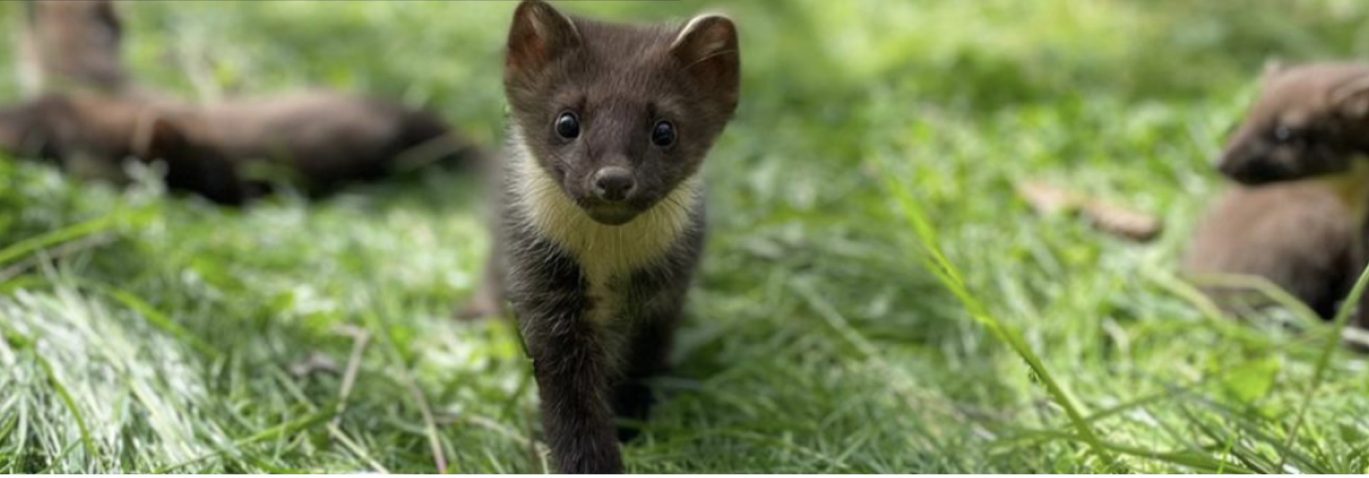
Stoats, Weasels & Pine Martens
Stoats, weasels and pine martens all belong to the mustelid family, a group of mammals characterised by their long, slim bodies and short legs.
Stoats, weasels and pine martens all belong to the mustelid family, a group of mammals characterised by their long, slim bodies and short legs. Their body shape enables them to chase their prey through tight tunnels and burrows. It can be difficult to tell stoats, weasels and pine martens apart, particularly because they are mostly spotted at dusk or night time, but pine martens are much larger than their stoat and weasel cousins.
Weasels are the smallest of the mustelid family and have chestnut brown fur with a cream-white belly. The line where the two colours meet is usually quite irregular in weasels.
Stoats are slightly larger than weasels. They have a long tail with a distinctive black tip which makes it easier to tell them apart from weasels. Stoats have a more sandy-brown coloured coat with a cream belly, and the division between brown and cream fur is more distinct.
It’s less common to spot a pine marten because they are more strictly nocturnal and spend much of their time in heavily wooded areas, as their name suggests. Pine martens are much larger than stoats and weasels (about the size of a cat) but they share similar colourings and markings. They also have large, rounded ears and a long bushy tail. Whilst stoats and weasels can climb trees, pine martens are much more agile climbers. Despite their larger size and darker coat, pine martens are sometimes mistaken for squirrels.
Where do stoats, weasels and pine martens live?
Stoats and weasels are widespread across Scotland. They live in lots of different habitats including woodland, grassland, and moorland. They thrive when there is an ample food supply, shelter and protection from larger prey. These stealthy mammals take over dens or burrows from their prey, living in places like old rabbit warrens.
Similarly, pine martens live in woodlands but they can also make their homes in rocky hillside areas. They are very defensive of their territory and will leave droppings on rocks where they can be easily seen by intruders. They make nests between rocks and have been known to live in squirrel dreys and bird nests or in the hollows of trees.
Stoats, weasels and pine martens are solitary animals so males and females live in separate territories, only coming together to breed.
What do they eat?
Stoats, weasels and pine martens prey on small mammals such as rabbits, mice and voles but will also hunt birds, amphibians and insects. When live prey is scarce they may eat berries, fruit and eggs.
When are baby stoats, weasels and pine martens born?
Although stoats, weasels and pine martens are similar in many ways, their breeding habits are very different.
That’s wild
Stoats, weasels and pine martens have an extremely high metabolism and eat up to a third of their own body weight daily.
Stoat
Male stoats will seek out a female to mate with in early summer. Incredibly, fertilisation is delayed for around nine months. The mother then gives birth to between six and twelve young, called kits, in the spring time. Most females will only have one litter in their lifetime and young stoats begin to hunt with their mother at eight weeks of age.
Weasel
Female weasels usually have smaller litters of around four to six kits born between April and August, but can have up to two litters a year. Young weasels are raised in their nest or den and are weaned after three to four weeks. The kits will be fully independent within three months.
Pine Marten
They build their breeding nests between rocks, in tree hollows or in nests they have taken over from their prey and mate above ground. Three to five kits are born in April and become independent from their mother by summer time.
Protection of Pine Martens
Pine martens are a protected species; it is an offence to deliberately or recklessly harass, capture, injure or kill them. It is also an offence to disturb, damage or destroy a breeding site or resting place of a pine marten or obstruct their access, whether or not a pine marten is present.
Stoats and weasels do not share the same protections and licensed individuals routinely control both species.
Common problems
Bad reputation
Sadly, stoats, weasels and pine martens face contempt from some people because they sometimes kill and eat chickens or gamebirds.
Snares and traps
Some lethal means of control against stoats and weasels are legal but snares and traps are indiscriminate. Pine martens can get caught in snares and traps which have been legally set to catch other species.
We support an outright ban on the use of snares and we want tighter regulations around traps due to the level of suffering caused.
Snares must be set correctly by a trained and authorised individual. All snares must have a ‘stop’ on them to prevent them from over-tightening. A legal snare or trap will have an ID tag and must be checked every 24 hours.
It is illegal for anyone to tamper with a legally-set snare or trap so we would ask the public not to attempt this. If you suspect a device is set illegally, call our helpline immediately on 03000 999 999.
Orphaned kits
Stoat, weasel and pine marten kits rely on their mothers for at least the first few months of life, depending on the species. If a mother stoat, weasel or pine marten is killed or scared off, the kits are unlikely to be able to fend for themselves in the wild.
Should you come across a young stoat, weasel or pine marten on their own, monitor them from a distance so long as the kit is in a safe place. If the mother does not return within an hour or two, or before dark, call our helpline on 03000 999 999.
Road traffic accidents
Sadly, road traffic accidents pose a threat to stoats, weasels and pine martens. If you come across one that has been killed in a road collision, your local council will be able to safely uplift the body. If the animal is injured, contact our helpline immediately on 03000 999 999.
Sick or injured animals
If you come across an injured or sick stoat, weasel or pine marten, contact our helpline on 03000 999 999.
Signs to be aware of include:
- Twitching.
- Not reacting to noise.
- Falling over.
- Not moving away when approached by a human.
- Open wounds.
- Breathing with mouth open or panting heavily.
- Lots of flies around the animal.
You should monitor them until one of our animal rescue officers arrives to assist. Do not attempt to hold or touch the animal.

Support us from £5 a month
It costs us £63,000 every day to continue the work that animals across Scotland depend on. Our work is only possible because of the generosity of people like you.


